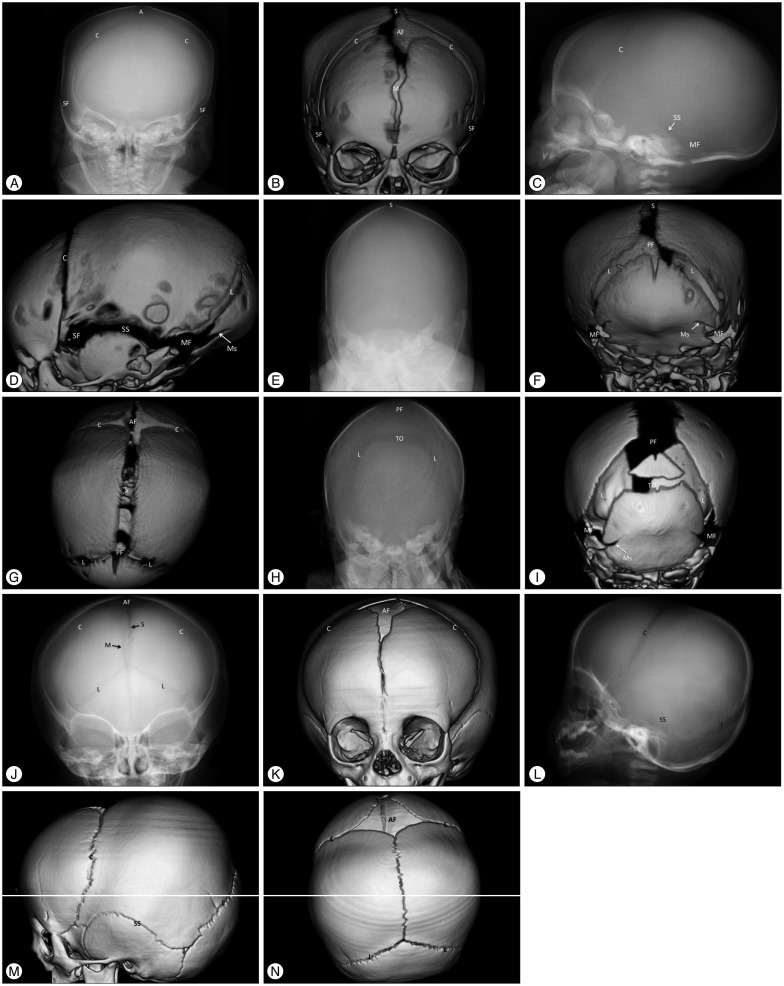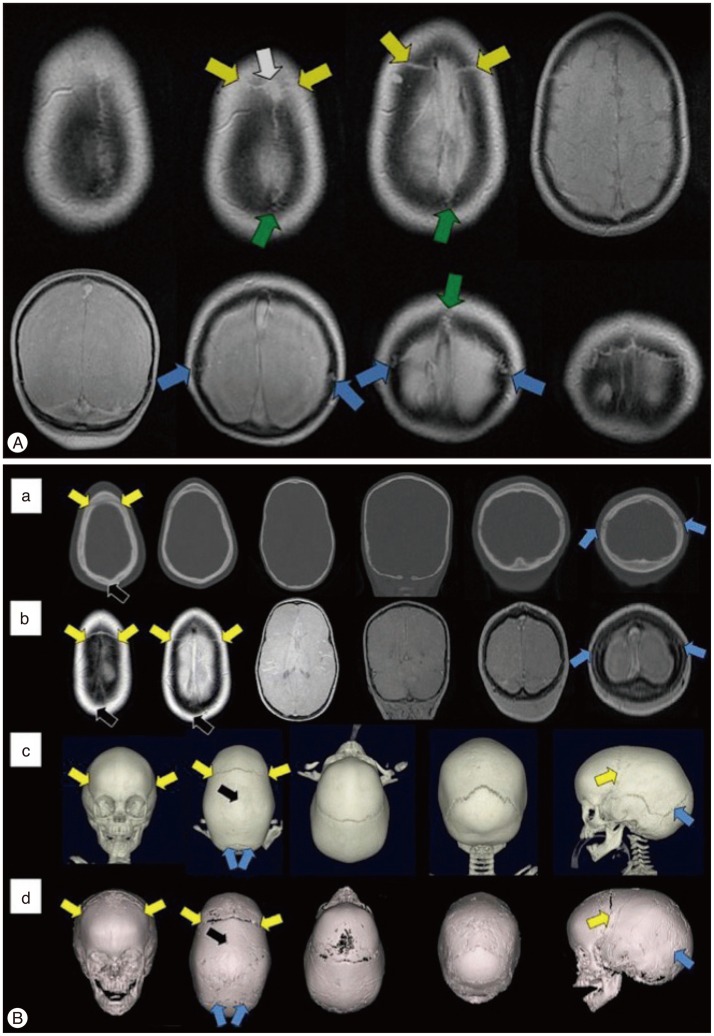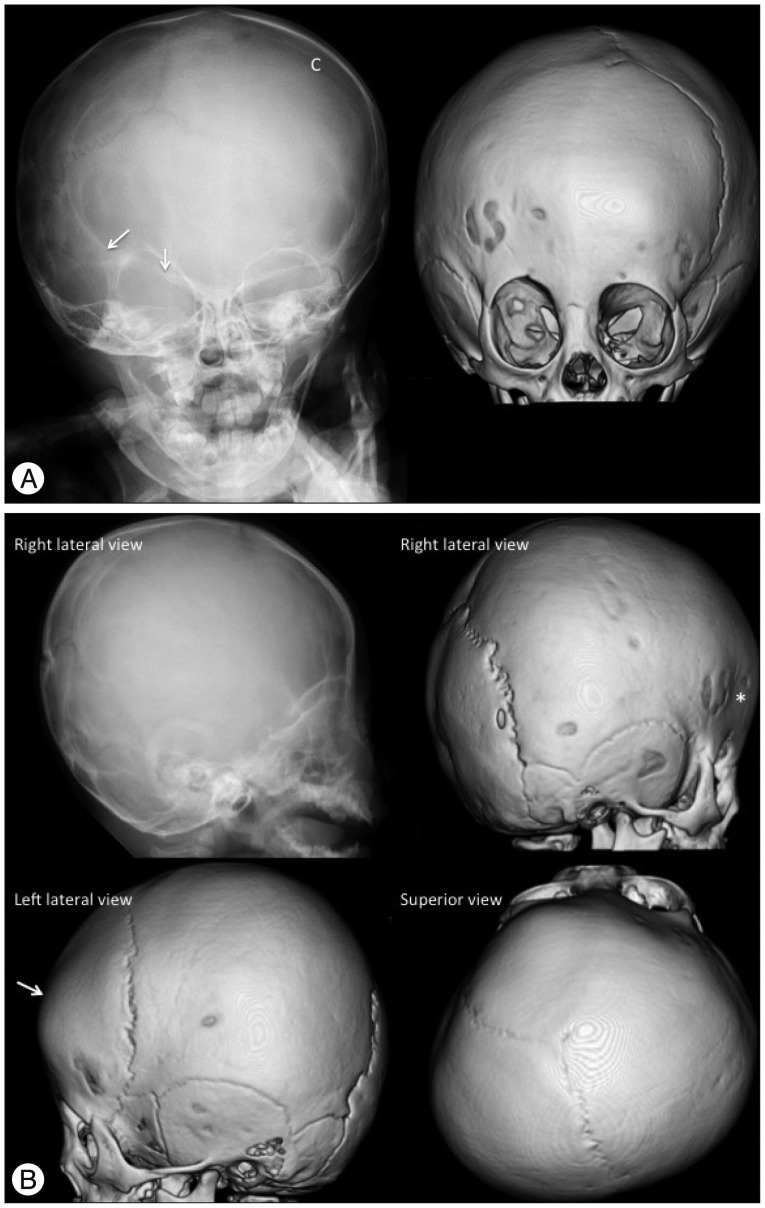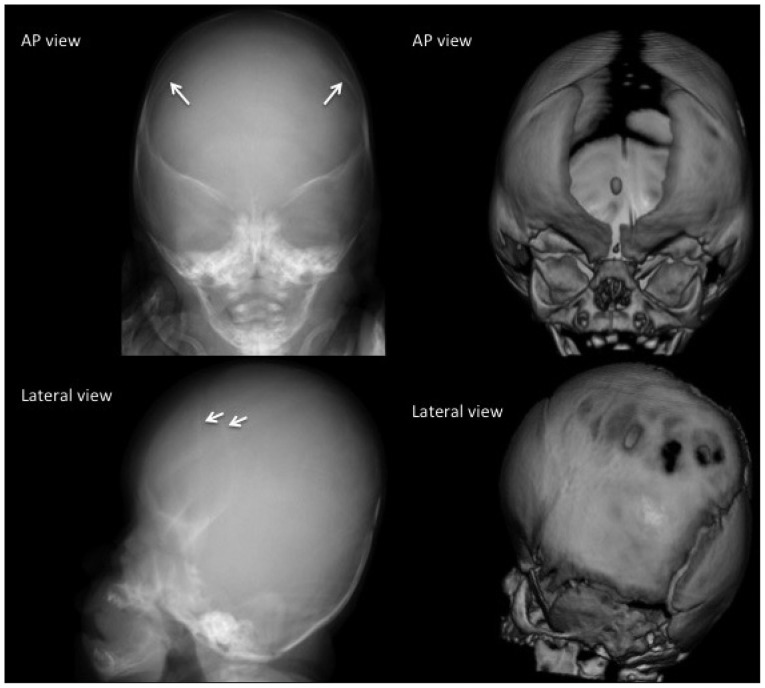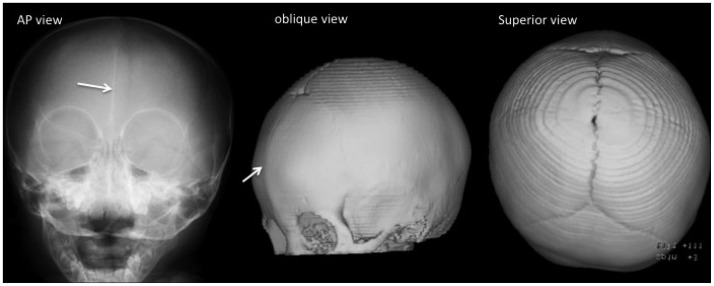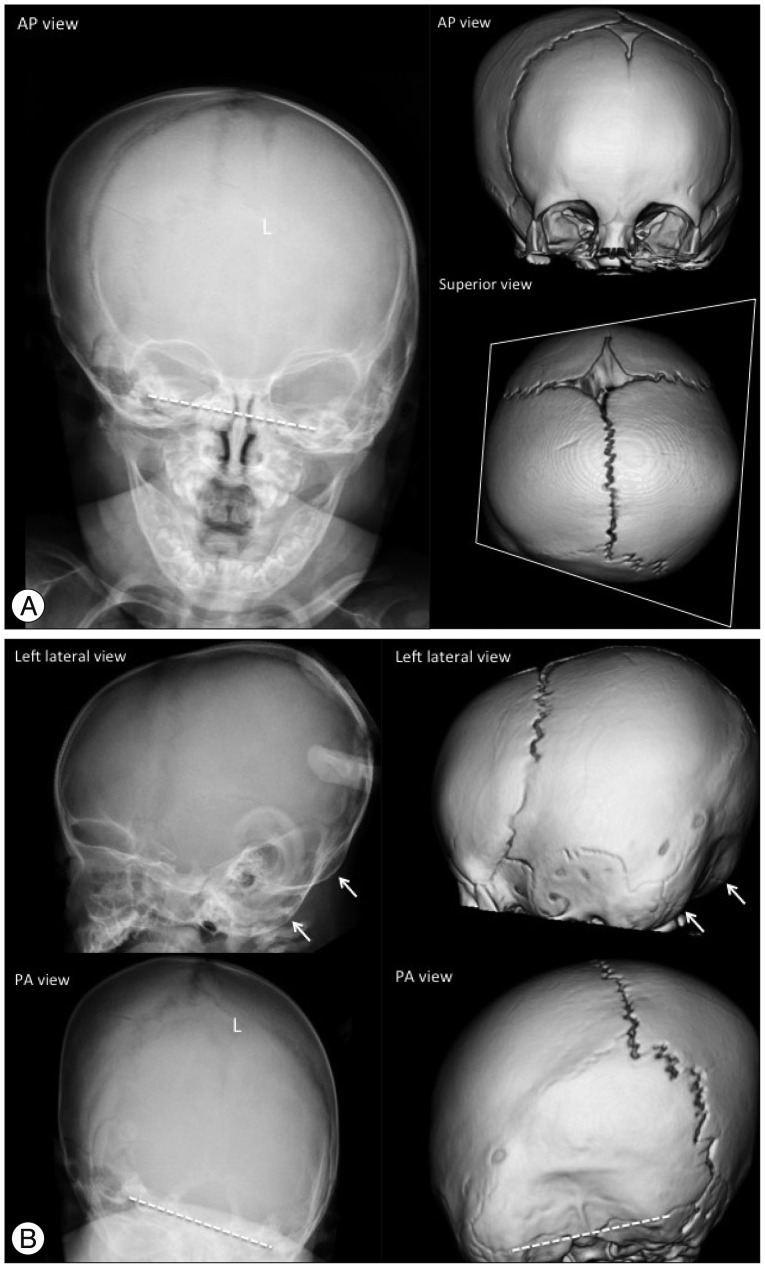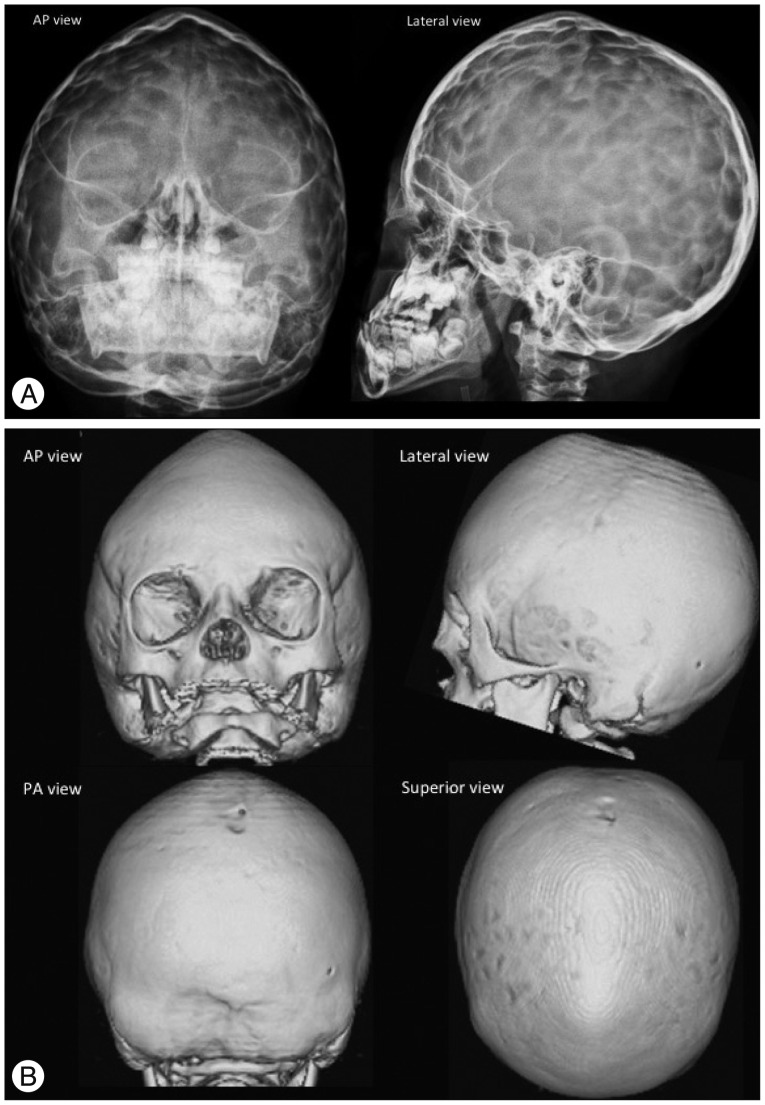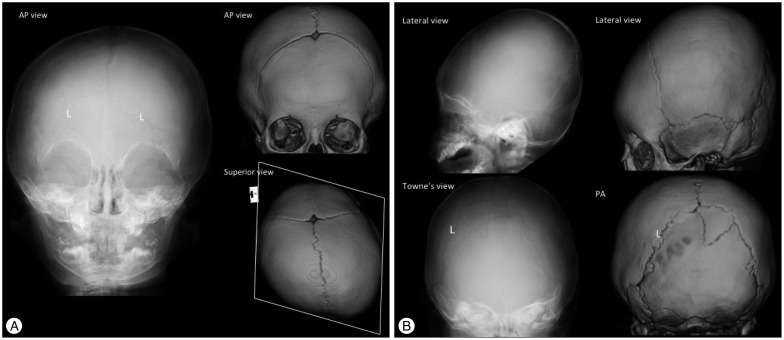J Korean Neurosurg Soc.
2016 May;59(3):219-226. 10.3340/jkns.2016.59.3.219.
Craniosynostosis : Updates in Radiologic Diagnosis
- Affiliations
-
- 1Department of Radiology, Daejeon St. Mary's Hospital, The Catholic University of Korea, Daejeon, Korea.
- 2Department of Radiology, Konkuk University Medical Center, Konkuk University School of Medicine, Seoul, Korea.
- 3Department of Neurosurgery, Daejeon St. Mary's Hospital, The Catholic University of Korea, Daejeon, Korea. leeilwoo@catholic.ac.kr
- KMID: 2192091
- DOI: http://doi.org/10.3340/jkns.2016.59.3.219
Abstract
- The purpose of this article is to review imaging findings and to discuss the optimal imaging methods for craniosynostosis. The discussion of imaging findings are focused on ultrasonography, plain radiography, magnetic resonance imaging and computed tomography with 3-dimensional reconstruction. We suggest a strategy for imaging work-up for the diagnosis, treatment planning and follow-up to minimize or avoid ionized radiation exposure to children by reviewing the current literature.
Keyword
MeSH Terms
Figure
Reference
-
1. Badve CA, K MM, Iyer RS, Ishak GE, Khanna PC. Craniosynostosis : imaging review and primer on computed tomography. Pediatr Radiol. 2013; 43:728–742. quiz 725-727. PMID: 23636536.
Article2. Branson HM, Shroff MM. Craniosynostosis and 3-dimensional computed tomography. Semin Ultrasound CT MR. 2011; 32:569–577. PMID: 22108219.
Article3. Calandrelli R, D'Apolito G, Gaudino S, Sciandra MC, Caldarelli M, Colosimo C. Identification of skull base sutures and craniofacial anomalies in children with craniosynostosis : utility of multidetector CT. Radiol Med. 2014; 119:694–704. PMID: 24510759.
Article4. Cohen MM Jr. Craniosynostosis and syndromes with craniosynostosis : incidence, genetics, penetrance, variability, and new syndrome updating. Birth Defects Orig Artic Ser. 1979; 15:13–63. PMID: 393319.5. Didier RA, Kuang AA, Schwartz DL, Selden NR, Stevens DM, Bardo DM. Decreasing the effective radiation dose in pediatric craniofacial CT by changing head position. Pediatr Radiol. 2010; 40:1910–1917. PMID: 20686761.
Article6. Eley KA, Watt-Smith SR, Sheerin F, Golding SJ. "Black Bone" MRI : a potential alternative to CT with three-dimensional reconstruction of the craniofacial skeleton in the diagnosis of craniosynostosis. Eur Radiol. 2014; 24:2417–2426. PMID: 25038852.
Article7. Ernst CW, Hulstaert TL, Belsack D, Buls N, Van Gompel G, Nieboer KH, et al. Dedicated sub 0.1 mSv 3DCT using MBIR in children with suspected craniosynostosis : quality assessment. Eur Radiol. 2016; 26:892–899. PMID: 26123408.
Article8. Jaffurs D, Denny A. Diagnostic pediatric computed tomographic scans of the head : actual dosage versus estimated risk. Plast Reconstr Surg. 2009; 124:1254–1260. PMID: 19935310.
Article9. Kaasalainen T, Palmu K, Lampinen A, Reijonen V, Leikola J, Kivisaari R, et al. Limiting CT radiation dose in children with craniosynostosis : phantom study using model-based iterative reconstruction. Pediatr Radiol. 2015; 45:1544–1553. PMID: 25939873.
Article10. Kirmi O, Lo SJ, Johnson D, Anslow P. Craniosynostosis : a radiological and surgical perspective. Semin Ultrasound CT MR. 2009; 30:492–512. PMID: 20099636.11. Lenton KA, Nacamuli RP, Wan DC, Helms JA, Longaker MT. Cranial suture biology. Curr Top Dev Biol. 2005; 66:287–328. PMID: 15797457.
Article13. Nagaraja S, Anslow P, Winter B. Craniosynostosis. Clin Radiol. 2013; 68:284–292. PMID: 22939693.
Article14. Persing JA, Jane JA, Shaffrey M. Virchow and the pathogenesis of craniosynostosis : a translation of his original work. Plast Reconstr Surg. 1989; 83:738–742. PMID: 2648432.15. Regelsberger J, Delling G, Helmke K, Tsokos M, Kammler G, Kränzlein H, et al. Ultrasound in the diagnosis of craniosynostosis. J Craniofac Surg. 2006; 17:623–625. discussion 626-628. PMID: 16877903.
Article16. Schweitzer T, Böhm H, Meyer-Marcotty P, Collmann H, Ernestus RI, Krauß J. Avoiding CT scans in children with single-suture craniosynostosis. Childs Nerv Syst. 2012; 28:1077–1082. PMID: 22349960.
Article17. Schweitzer T, Kunz F, Meyer-Marcotty P, Müller-Richter UD, Böhm H, Wirth C, et al. Diagnostic features of prematurely fused cranial sutures on plain skull X-rays. Childs Nerv Syst. 2015; 31:2071–2080. PMID: 26298825.
Article18. Slater BJ, Lenton KA, Kwan MD, Gupta DM, Wan DC, Longaker MT. Cranial sutures: a brief review. Plast Reconstr Surg. 2008; 121:170e–178e.
Article19. Soboleski D, McCloskey D, Mussari B, Sauerbrei E, Clarke M, Fletcher A. Sonography of normal cranial sutures. AJR Am J Roentgenol. 1997; 168:819–821. PMID: 9057541.
Article20. Soboleski D, Mussari B, McCloskey D, Sauerbrei E, Espinosa F, Fletcher A. High-resolution sonography of the abnormal cranial suture. Pediatr Radiol. 1998; 28:79–82. PMID: 9472048.
Article21. Sze RW, Parisi MT, Sidhu M, Paladin AM, Ngo AV, Seidel KD, et al. Ultrasound screening of the lambdoid suture in the child with posterior plagiocephaly. Pediatr Radiol. 2003; 33:630–636. PMID: 12879318.
Article22. Vazquez JL, Pombar MA, Pumar JM, del Campo VM. Optimised low-dose multidetector CT protocol for children with cranial deformity. Eur Radiol. 2013; 23:2279–2287. PMID: 23504037.
Article23. Weinzweig J, Kirschner RE, Farley A, Reiss P, Hunter J, Whitaker LA, et al. Metopic synostosis : Defining the temporal sequence of normal suture fusion and differentiating it from synostosis on the basis of computed tomography images. Plast Reconstr Surg. 2003; 112:1211–1218. PMID: 14504503.
Article
- Full Text Links
- Actions
-
Cited
- CITED
-
- Close
- Share
- Similar articles
-
- Update of Diagnostic Evaluation of Craniosynostosis with a Focus on Pediatric Systematic Evaluation and Genetic Studies
- Genetic Syndromes Associated with Craniosynostosis
- Current and Future Perspectives in Craniosynostosis
- Unilateral Lambdoid Craniosynostosis in a Twin-to-Twin Transfusion Syndrome Donor: A Case Report
- Moleculobiological Analysis of Fibroblast Growth Factor Receptors in Korean Patients with Craniosynostosis

